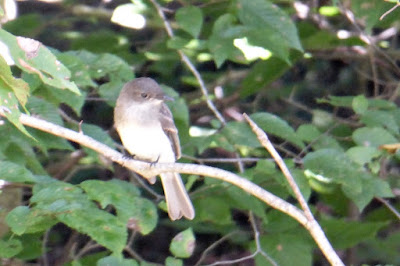My trip to Fairfield in March 2018 was the sixteenth now documented in this blog. Yes, it's taken a while for me get started on this entry. I promise to keep it brief, so let's jump in:
I stayed at the Men's Peace Palace, as last time. Given the time of year, I saw lots of sunrises, and some were photo-worthy.
The entryway looked familiar, including the reminders on the floor to remove one's shoes.
I finally noticed that the coat hangers in the entryway bore duck heads.
It was the same room I had back in November.
In the middle of one thunderstorm-wracked night the power went out on parts of the campus, including the Peace Palace. My battery-powered clock woke me at the correct time, but I couldn't turn on any lights. I was able to navigate with my camping headlamp, and the building's hot water was still comfortably warm when I turned it all the way to "H," so no harm done. The power came back later in the morning.
My two-week visit included five days of Ayurvedic treatments at The Raj, which were welcome and very settling. One evening I took this photo combining the entry and the moon.
The shirodhara treatment, oil poured slowly on the forehead, was especially calming.
Between the extended group meditations in the Golden Dome, my Raj treatments, and iffy weather I had only a few opportunities to wander. On one of my walks I discovered that the old railroad depot had undergone another reincarnation.
The expansion of the North Campus Village was continuing.
 |
| Is that a giant spider up there? |
Concrete was being poured.
This zoom shows some of the tubing and mechanisms of a long-distance pour. Click on the image to enlarge.
 |
| Sure it's not injecting alien eggs into the ground? |
On one of my walks uptown -- or is it downtown? -- near the square, anyway, this juxtaposition caught my eye.
 |
| That's Fairfield! |
Now for my campus-area photos; first, an engaging trio of trees near the student union.
A Chevy Volt was charging up near the Sustainable Living Center.
On the other side of the green battery shed, a student project had been installed next to the photovoltaic panels.
EVSE is an acronym for Electric Vehicle Service Equipment. The charging equipment within the car and the EVSE negotiate a power level for charging that's acceptable to both parties.
OpenEVSE is an outfit that will either sell you a completed EVSE, an EVSE kit that you assemble, or parts to build an EVSE to your own specifications.
Here's a view of the central hallway of the Sustainable Living Center. The whole trunks are much stronger than sawn boards.
I had the opportunity to walk another segment of the Jefferson County Loop Trail, which I have explored over the years. A schedule conflict, however, prevented me from collecting the final mile needed to claim the entire trail.
On the afternoon of March 25th there was to be a Global Group Meditation, where TM practitioners everywhere would gather in groups and meditate at the same time, 5:05 pm in Fairfield. This effort, it was anticipated, would tweak the global level of consciousness for the better. Of particular interest, Maharaja Adhiraj Rajaraam -- also known as Dr. Tony Nader -- would be addressing those of us in Fairfield (via audio link) and answering questions before the meditation start.
Although tempted to complete my walk I cut it short. This was wise, because the treatments at the Raj had calmed my metabolism a lot, and I was getting accustomed to a new prescription. I knew I shouldn't stress myself with an extra two miles.
At the Dome the gathered souls were first addressed by Dr./Raja John Hagelin, and a video of him was played, explaining the mechanics of how group practice could affect the greater population. His background as a physicist was put to good use in the video. John also wished another TM notable, Raj Rajeshwari Candace, a happy birthday.
The program then moved to Dr. Nader, who also spent time noting Candace's birthday and praising her works, followed by Candace's thanks, which quickly transformed into lengthy admiration of Dr. Nader's insights and leadership. After a final return expression of thanks to Candace, Dr. Nader unfortunately had time to answer only one question. Then it was the start time for the global meditation.
A look back at the Dome when it was all over, and I was on my way to the Golden Dome Market Cafe for a light dinner.
After a rejuvenating visit to Fairfield I returned home. As for the loop trail -- maybe next time!
































































